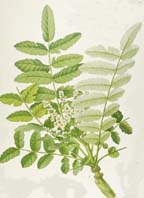-- Cheryl in KS (klingonbunny@planetkc.com), September 04, 2002.
Daily Herb Listing - Frankincensegreenspun.com : LUSENET : Country Style Homesteading : One Thread |
September 4, 2002FRANKINCENSE
Latin Name: Boswellia carteri
Alternate Names: Galbanum
Family: BURSERACEAE
Parts Used: Oleo resin.
Properties: Alterative, Analgesic, Aromatic, Antiseptic, Antispasmodic, Emmenagogue, Nervine, Rejuvenative.
Internal Uses: Amenorrhea, Dysmenorrhea
Internal Applications: Tea, Tincture, Capsules.
Topical Uses: Asthma, Athletic Injuries, Bronchitis, Emphysema, Mouth Sores, Rheumatism, Wounds
Topical Applications: Liniment for rheumatism and athletic injuries. Salve for wounds. Mouthwash for sores. Used in perfumes. Burned in hospitals to prevent the spread of infectious diseases. Vapours inhaled (by boiling resin in water) for respiratory problems such as asthma, bronchitis, and emphysema.
Energetics: Pungent, Bitter, Warm.
Chemical Constituents: Boswellic acids, olibanoresene, arabic Acids, pinene, bassorin, monoterpene hydrocarbons.
Contraindications: Use only small amounts internally for short periods of time. Not to be used during pregnancy.
Comments: The genus name, Boswellia, is named after Scottish botanist, John Boswell (1719-1780). Commonly burned as an incense, Frankincense has long been burned to consecrate temples and to mask odors of cremation. Its smell is said to calm and clear the mind.
The common name Frankincense also includes the species Boswellia thurifera, which is used interchangeably with Boswellia carteri.
-- Cheryl in KS (klingonbunny@planetkc.com), September 04, 2002

-- Cheryl in KS (klingonbunny@planetkc.com), September 04, 2002.